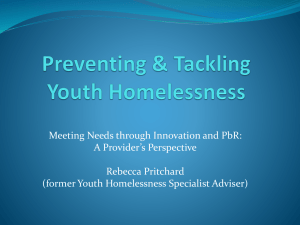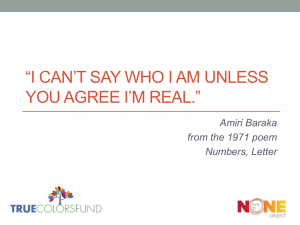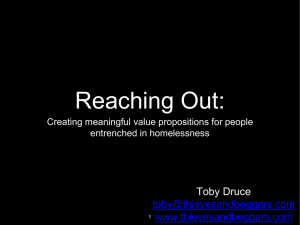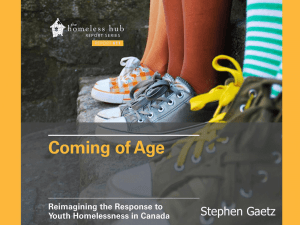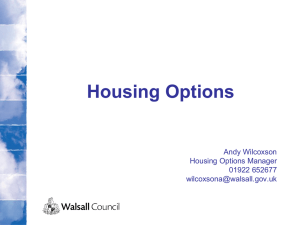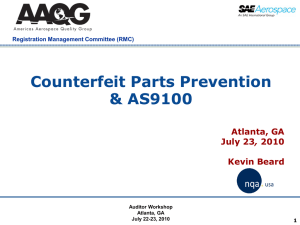A Seat at the Table: Homeless Liaisons Building Collaborations on
advertisement
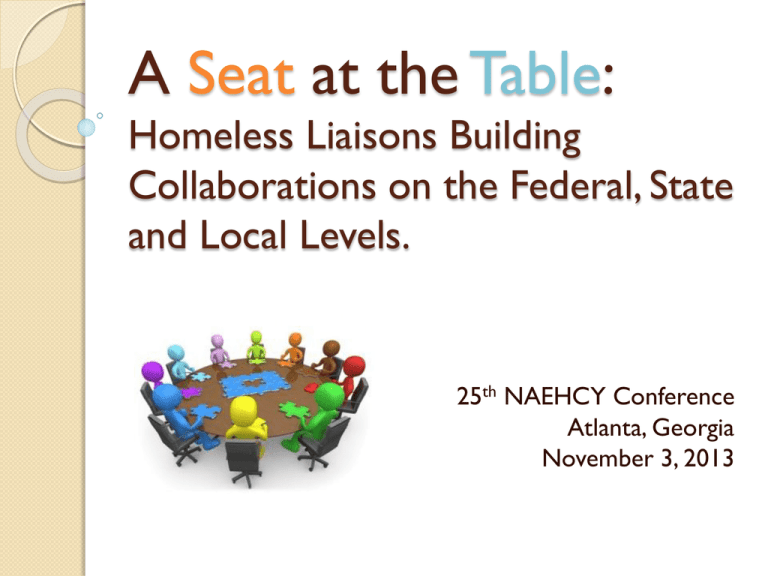
A Seat at the Table: Homeless Liaisons Building Collaborations on the Federal, State and Local Levels. 25th NAEHCY Conference Atlanta, Georgia November 3, 2013 Why are we here? Session Goals I. Participants will gain an understanding of federal, state and local community based initiatives to enhance program objectives. II. Participants will learn tools for engaging community stakeholders and creating a “seat at the table.” III. Participants will gain insight on community partnerships that result in the educational and housing needs of students facing homelessness. IV. Participants will learn to navigate the differences in McKinney-Vento definitions for education and housing agencies to better serve families. Dedicating Opportunities to End Homelessness: Place – Based Strategies to Prevent and End Homelessness Opening Doors – 2010 Obama Administration First comprehensive federal strategic plan to prevent and end homelessness that calls for an alignment of federal, state, local, and private resources with four goals. Goals of 2010 Opening Doors Plan 1. 2. 3. 4. Finish the job of ending homelessness by 2015; Prevent and end homelessness among veterans by 2015; Prevent and end homelessness for families, youth and children by 2020; and Set a path to ending all types of homelessness. Opening Doors Strategies End homelessness by leveraging collaborations: Mainstream Housing 2. Health 3. Education 4. Human Services 1. Dedicating Opportunities to End Homelessness (DOEH) Cont. Joint effort between the U.S. Department of Housing and Urban Development (HUD) and the United States Interagency Council on Homelessness (USICH) – community based strategy development to better and maintain itself. Ten Cities: Atlanta, Chicago, Fresno County, Los Angeles County, Houston, New Orleans, Philadelphia, Phoenix/Maricopa County, Seattle, and Tampa. DOEH & McKinney Vento Themes Awareness – DOEH Families and Children, Social Services and Public Affairs subcommittees. Collaboration and Coordination of Services – DOEH collaborations gives access to federal, state and local resources needed. DOEH – Agencies at the Table HUD & USICH & Veterans Affairs Department of Community Affairs Continuum of Care County Government Shelters Transitional Housing Agencies Faith Based/ Ministries Law Centers for Homeless Mental Health Divisions of Hospitals Why is it important to develop community based partnerships? Parents need multiple sources of support to help their children succeed in school and in their communities. Research demonstrates that effective schools/education programs have high levels of parental and community involvement. Strategies for Developing Relationships: All providers can: Learn each other’s definition of homelessness Create a space for open discussion about shared values and gaps in service Identify community stakeholders to partner with on activities that advance common values and goals Attend each others’ meetings Develop MOUs for cooperation and information sharing Promising Partnership Practices Determine Shared Vision and Values Develop a Plan Communicate Establish Connections Share Leadership Build Collaborations Mutual Stakeholder Engagement Children – includes student and family needs. Parent Teacher Organizations, Non Profit arm, Parents As Leaders Teachers – instructional support insight. M-V teacher tutors Administration – instructional/ school supports. Continued awareness and technical assistance Community Based Non Profits – varied missions. Early Child hood Education Centers, United Way, Big Brothers/Big Sisters, Boy/Girl Scouts, Junior Achievement, Operation Hope, Junior Leagues, Kiwanis Clubs Neighborhood Coalitions – betterment of residents. Business Associations, In Town Associations, Foundation Civic Sites Faith Institutions – betterment of surrounding communities. Churches, Mosques, Synagogues Businesses – venues and consumer needs. Corporate Foundations, Neighborhood Businesses, Future Business Government Agencies – citizen services. Police Department, Health Clinics, Social Services and Libraries Universities – sporting events tickets for family bonding and attendance incentives. Atlanta Public Schools Example Homeless Education Advisory Board Mission: The Atlanta Public School Homeless Education Program seeks to actively and regularly engage key, Atlanta – based community stakeholders in ensuring the academic success of students in transition. Vision: The Atlanta Public School Homeless Education Program Advisory Board will meet twice per school year to be updated on the issues facing students in transition. The board will leverage their networks in providing opportunities for students to gain life skills and exposure to activities that ultimately boosts the academic esteem of this at-risk population. Other Partnership Results: Community Agency Yearly Outcome United Way of Greater Atlanta 8 pallets of school supplies Focus North America 1000 sneakers Atlanta Police Athletic League 25 slots for homeless students Furniture Bank of Metro Atlanta 100 beds to families transitioning to permanent homes Georgia Campaign for Adolescent Power & Potential 15 doulas and life coaches with housing and child care APS Central Office 30 families adopted for holiday giving Georgia State University 150 tickets per home football and basketball games Assistance League of Atlanta 1800 uniforms for elementary school students, 700 coats and 500 hygiene kits Every year: Atlanta Center for Self 1 week of transportation passes at about Sufficiency, Georgia Law Center $10 – covers a school year for 550 for the Homeless & MARTA students. A case in housing: 1. 2. 3. 4. HEARTH Act: Initial Assurances: The Continuum of Care (CoC)Applicant must demonstrate collaboration with education agencies. The CoC must consider the educational needs of children and not disrupt children’s education. Project applicants must demonstrate practices consistent with McKinney –Vento Act. Applicants must designate staff to ensure children are enrolled in school and connected to services. McKinney – Vento Data HUD versus McKinney – Vento Impact Collaboration Experts Speak… Jimyu Evans, Project Community Connections Jatisha Marsh, Atlanta Public Schools Stephen Vault, WellStar Sustainability Share responsibility with schools and other community organizations committed to engaging families in meaningful, culturally respectful ways, as well as families actively supporting their children’s learning and development. Continue across a student’s life, beginning in infancy and extending through college and career preparation programs. Carry out everywhere children are raised and taught including homes, early childhood education programs, schools, after-school programs, faith-based institutions, playgrounds, and community settings. Position Statement on School-Family-Community Partnerships for Student Success (2009). Connecticut State Board of Education. http://www.sde.ct.gov/sde/LIB/sde/pdf/board/SFCP.pdf Sonya O. Hunte, MSW shunte@atlanta.k12.ga.us Homeless Education Liaison 130 Trinity Avenue 2nd Floor Atlanta, GA 30303 Office (404) 802-2245 Fax (404) 802-1205



